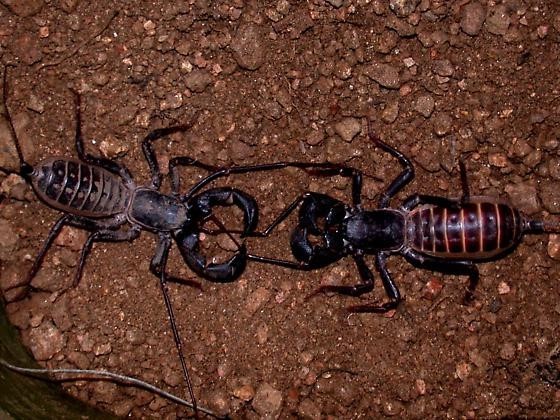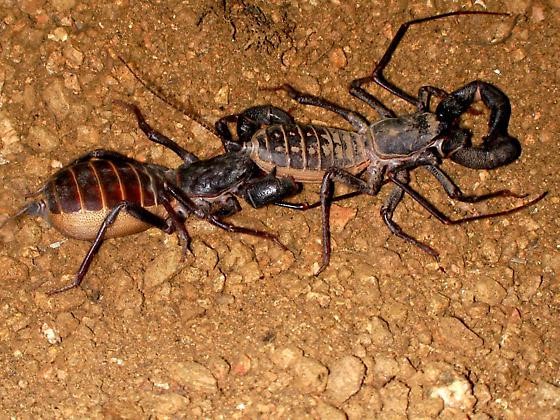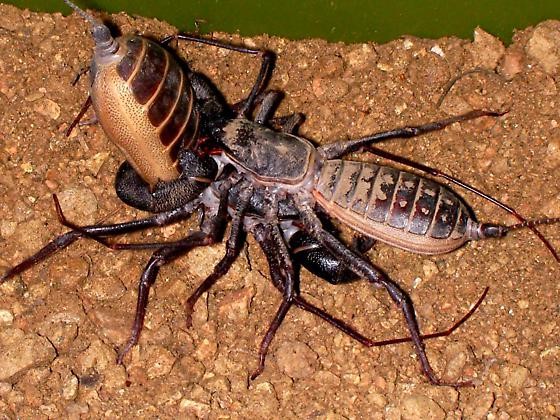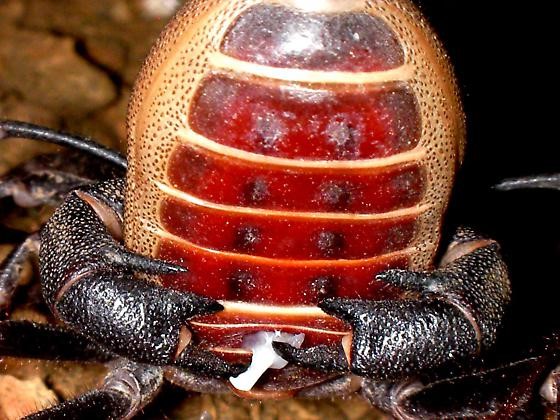Life History and Reproduction
M. giganteus has been found
to have been around longer than mammals and has fossil record of
being around 350 million years ago (Schmidt 2009). Yet, surprisingly
only minimal information is known about them. We do not know a lot about
these creatures due to them being so strictly nocturnal and being
underground or hidden most of their lives (Weygoldt 1971, Schmidt 2009). Another reason it is so hard to get information and data on
these animals is because they are so aware of their surroundings and
can sense observers (Schmidt 2009). Yet we do know their life cycle.
It begins with an egg phoretic larval stage leading to 4 free-living
larval instar stages, and an adult stage (Schmidt 2009). We also
know once they are mature, after about four
years, they do not molt again and each of the four instar stages
takes M. giganteus about one year to shed their
exoskeletons (Cincinnati Zoo). However they are able to hold off
molting for about a year depending on the environment and the
amount of food there is (Schmidt 2009). Before they can molt however
they usually do not eat and spend a long time in their burrows. The
time they spend in their burrows while molting can range from a
couple of weeks to a couple of months (Weygoldt 1971).
M.
giganteus reproduce at night during the end of the summer
foraging season, once they reach sexual maturity after about 3-4
years (Weygoldt 1971, Cincinnati Zoo). The whip scorpion lives about
four years after sexual maturity with males living for about 10
years while the females live for about 20 years (Kern and Mitchell 2011,
Beardsley Zoo, Cincinnati Zoo). M. giganteus
mating ritual on average takes 13 hours and involves four different
phases; Chase and grapple, dancing, generation, and pressing
(Weygoldt 1971, Schmidt 2009).

The sexual process begins with phase one which is chase and grapple.
During this time the female is testing the male as they push each
other around, which often looks like a fight between the two whip
scorpions. They have been known to be seen at times picking each
other up off the ground. This stage has been known to take as little
as one minute, either resulting in the female not agreeing, or
agreeing to mate with the male. If the female agrees to mate with
the male she then shakes her sensory legs in front of the male
allowing him to grab them with his pedipalps, completing phase one
(Weygoldt 1971, Schmidt 2009).
The next
phase, called dancing, the two whip scorpions face each other and
the male pulls the female forward and backward while holding her
sensory legs (Schmidt 2009). During this time the female opens her
pedipalps and tries to get away by either moving backward or to the
side, although she is not resisting (Weygoldt 1971). This process is
known as further testing of the male, as well as a means of finding
shelter (Schmidt 2009). This phase of the sexual process may last
between 2-3 hours leading to phase three (Weygoldt 1971, Schmidt 2009).

Phase three,
which is known as the generation phase, the male uses a lot of his
energy. This phase lasts about 4.6 hours while the male creates his
two 7mm long and curved sperm sacs on a base plate called a
spermatophore (Weygoldt 1971, Schmidt 2009). The male turns until he
is in front facing the same direction as the female, while the
female holds his opithosoma with her pedipalps. They then stay in
this position without moving for about 2.5 hours (Weygoldt 1971).
The male at this time is looking, with his sensory legs, for a place
to lay down his sperm sacs. Once the male finishes producing his
spermatophore he then rubs his gonopore on the ground and deposits
it. Once deposited the male then pulls the female over the sperm
sacs as she picks them up with her genital operculum, marking the
end of phase three (Weygoldt 1971, Schmidt 2009, Kern and Mitchell
2011, Beardsly Zoo).
The fourth
and final phase in whip scorpion sexual process is pressing. The
male at this time gets on top of the female facing the opposite
direction with his pedipalps wrapped around the female’s opisthosoma
(Weygoldt 1971). At this point the male then grabs the sperm sacs
and begins to move them side to side in the female’s genital slit,
to get the sperm out of them. This final phase takes around 4.8
hours to complete. This marks the end of the mating ritual the
animals now separate and never mate together again (Weygoldt 1971, Schmidt 2009).


The female
M. giganteus, after mated, go back into their burrows at
the end of the feeding season where they stay awake and alert. With
about 2.5 months before the next summer she makes a clear nursery
sac to hold her eggs which she attaches underneath her body (Schmidt
2009, Kern and Mitchell 2011). Each sac the female produces has
between 35-68 eggs and once they hatch they stay on their mothers
back inside her burrow until they molt for the first time (Schmidt
2009, Kern and Mitchell 2011). When
M. giganteus first hatch they are white and have no color to
them until they first molt. After their first molt they gain the
normal near black color, their exoskeleton hardens and they look
like miniature versions of their adult counterparts (Schmidt 2009).
Continue to Interactions
Return to Home
See References